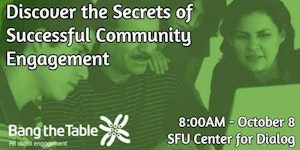We were excited to learn recently that Public Agenda and the Participatory Budgeting Project – two of our prominent NCDD member organizations – have released a new participatory budgeting evaluation toolkit in collaboration with the North American PB Research Board. The toolkit will help municipalities across the continent document the impacts and effectiveness of their local PB efforts. We encourage you read more about it in the Public Agenda article below or find the original here.
Evaluation Matters: A New Toolkit for Assessing Participatory Budgeting
![]() For those of us exploring ways to deepen and expand public participation in democracy, we know how essential evaluation is to our cause. Both government officials and the public have limited time, energy and resources. And furthermore, many may already be disillusioned by current and past efforts to include the public in decision making.
For those of us exploring ways to deepen and expand public participation in democracy, we know how essential evaluation is to our cause. Both government officials and the public have limited time, energy and resources. And furthermore, many may already be disillusioned by current and past efforts to include the public in decision making.
We need to be able to demonstrate to officials, the public, interested funders, community partners, and others that their investment in new public engagement methods will be worth it. Will more people participate, particularly those who have been historically less civically engaged? Will the new form of engagement lead to better decisions and policies that residents support? Will the public feel like their voices have been heard, and will they come to understand the complexities and trade-offs inherent in many policy decisions? Will the method build trust among officials and the public and open pathways for collaboration among community-based organizations and the government?
At the same time, we as public engagement practitioners are very busy. Evaluation can be time consuming and complicated, especially when we’re attempting to measure something amorphous like deeper public participation. As such, evaluation too often gets lost among everything else we’re doing.
For these and other reasons, we are particularly excited about one of our current projects: an initiative to help make it easier for practitioners to evaluate participatory budgeting efforts.
Communities across the country are experimenting with participatory budgeting (PB for short), which is one potential avenue for deeper public participation and engagement. Through PB, local residents get to decide how their community will spend a set amount of public money. Many of these communities, including some in New York, Chicago, Long Beach, CA and Dieppe, in New Brunswick, Canada, are also trying to track and measure how PB is affecting residents, officials, and neighborhoods.
Community members evaluating PB often have questions that are locally unique and relevant. At the same time, because many PB processes across the U.S. and Canada follow a similar structure, these evaluators are also often looking to answer common questions shared by communities.
To help foster collaboration among evaluators and facilitate shared learning on these questions, we have been working since the start of 2015 to support and coordinate local evaluation work. Ultimately, we hope that this will also lead to a better understanding of the successes and challenges of the PB movement as a whole.
One of our first steps has been to develop a toolkit for those tasked with evaluating PB in their communities. We developed the toolkit in concert with the Participatory Budgeting Project (PBP), the North American PB Research Board and local evaluators from numerous PB sites across the U.S. and Canada.
The toolkit includes key metrics – 15 in all – for capturing important elements of each local PB process specifically and the movement in North America generally. These metrics describe the way PB could impact things like civic life, equity, and governance.
To help ease the evaluation process and data collection, these metrics are paired with survey instruments that address the 15 key metrics. Evaluators can customize these survey instruments and use as needed. We also developed a questionnaire for evaluators that will help us and local evaluators to collect and share comparable data about PB processes across North America and over time.
The toolkit also includes a timeline to help evaluators best determine where and how to undertake PB evaluation at different stages of the PB process.
While we developed the metrics and survey instruments for participatory budgeting, the underlying concepts are applicable to evaluating other forms of public engagement, like deliberative meetings, community conversations, and citizen juries.
We hope these tools will help those working on participatory budgeting in their communities by taking some of the guesswork out of measurement and making time for other things like constituent outreach and engagement. If you’re interested in hearing more about evaluation and our work with PB researchers, you can join our listserv for the participatory budgeting community by sending an email here.
Have you voted in a PB process and want to get more involved? Or are you curious about PB and looking to introduce it to your community? The website and people of Participatory Budgeting Project are a great resource for those who are new to PB and want to know more. Introduce yourself to the Participatory Budgeting Project.
You can find the original version of this Public Agenda blog post at
www.publicagenda.org/blogs/evaluation-matters-a-new-toolkit-for-participatory-budgeting#sthash.SQWKGkAR.dpuf.

 Another way I see meetings in a “cathedral building” view, is that the process of the work (i.e., the quality of the conversations… the way we treat each other) is itself creating the world we want to see. I find it meaningful to be part of a global community of innovators (e.g., through
Another way I see meetings in a “cathedral building” view, is that the process of the work (i.e., the quality of the conversations… the way we treat each other) is itself creating the world we want to see. I find it meaningful to be part of a global community of innovators (e.g., through 






